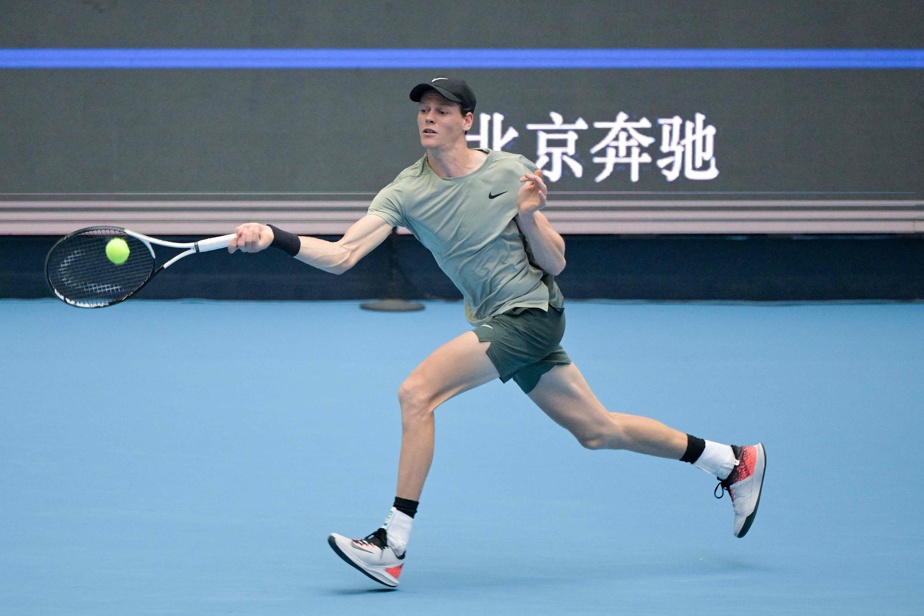(Paris) Development in the case of world No.1 Jannik Sinner: the World Anti-Doping Agency (WADA) announced on Saturday that it had appealed and is calling for a suspension of one to two years for the Italian player.
While he had been cleared by the International Tennis Integrity Agency (ITIA) after having twice tested positive for clostebol, an anabolic steroid, in March, Sinner was caught up in a case likely to shake up the hierarchy at the top of world tennis.
It is now the Court of Arbitration for Sport (CAS) which must decide in this case involving the winner of the Australian Open and the United States Open.
Sinner said he was “very disappointed and also surprised” by this call, Saturday after his victory over Russian Roman Safiullin in the round of 16 of the Beijing tournament. “There were three hearings and all three ended very positively for me,” he told the press.
In a statement released late in the afternoon, Sinner reiterated that he was “disappointed” and expressed his incomprehension.
It is difficult to understand what it will bring about three different judges examining the same facts and the same documents again.
Jannik Sinner
“But I have nothing to hide and as I have done all summer I will cooperate fully with the appeal proceedings and provide everything necessary to demonstrate my innocence once again,” he concluded. .
Over-the-counter spray
At first instance, an independent court concluded that the 23-year-old Italian player had committed “no fault or negligence”, a decision “not correct with regard to the applicable rules” according to WADA.
As a result, the anti-doping body based in Montreal “requests a suspension period of one to two years” against Jannick Sinner.
He had already had his ATP points withdrawn as well as the winnings obtained during the Masters 1000 in Indian Wells, the tournament during which he was declared positive and where he reached the semi-finals.
Jannik Sinner embodies with the Spaniard Carlos Alcaraz, the next generation of the ATP circuit. This season, the two players have shared the four Grand Slam tournaments.
Three weeks ago, Sinner became the first Italian player to win at Flushing Meadows.

PHOTO MIKE SEGAR, REUTERS
Jannik Sinner kisses the trophy won at the last US Open.
In full rise after winning his first major title, in Melbourne, Sinner had undergone two positive doping tests in March 2024 eight days apart: on March 10 during the Indian Wells tournament and on March 18 out of competition, but just before the Miami tournament. Trace amounts of clostebol were found in his urine.
Both times, the player appealed, which allowed him to reduce his automatic suspensions (from April 4 to 5 for the first, from April 17 to 20 for the second).
The Italian defended himself by explaining that he had suffered “contamination by a member of his staff, who had applied an over-the-counter spray containing clostebol to his own hand to treat a small wound”, according to the International Agency for Health. Tennis Integrity (ITIA) which accepted his defense and officially cleared him at the end of August.
Outraged reactions from players
This file recalls that of his compatriot Marco Bortolotti: tested positive for clostebol during the ATP Challenger tournament in Lisbon in October 2023, the Italian had also established “involuntary contamination” and had only lost the results obtained during this competition, without purge suspension.
The ITIA’s decision to clear the native of Trentino-Alto Adige had sparked outraged reactions from certain players, including the Australian Nick Kyrgios and the Frenchman Lucas Pouille.
Before the US Open, Sinner had separated from his physiotherapist Giacomo Naldi, who was supposed to have unintentionally contaminated him, and from his physical trainer, Umberto Ferrara, who had provided Naldi with the incriminated spray.
Since clostebol is not naturally produced by the body, no notion of threshold comes into account: it is enough to detect its presence for an anti-doping test to be considered positive.
The WADA classifies it as an “anabolic androgenic steroid”, a long list of testosterone derivatives capable of stimulating muscle growth, without however explaining what quantity would have a significant effect on performance.
